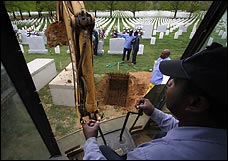A few jobs are simply outstanding. Others stand out because they’re unusual, virtually invisible or incredibly tedious. Most of us go to work five days a week, but just what “work” means has countless definitions.
“My job’s just to dig the holes. Dig the holes, then cover ’em back up. That’s what I’m here to do.”
Invisible to the people who arrive dressed in the dark elegance of mourning, Charles Montgomery, Sr., and his team will be the last to usher the honored dead into that good night.
Charles Montgomery stands in Arlington National Cemetery, in blue work clothes, a soiled ball cap and scuffed boots. He’s invisible to the people who arrive dressed in the dark elegance of mourning, weeping as the dirge of taps echoes yet again. After they depart, his hands will be the last to usher their honored dead into that good night.
Gravedigger to the fallen.
“Nobody told me nothing about them,” he says, as a slate sky spits rain on the ground that awaits in Section 60 of the cemetery.
Like all aspects of military life, the job requires precision. If grave-digging can be described as ordinary, this is no ordinary grave-digging: Only perfection befits the nation’s most revered deceased.
First, the plots are located with a survey map, measured and marked with wooden pegs, each plot 10 feet long and five feet wide.
After the honor guard and mourners have left, after the flags have been folded in triangles and carried off by relatives of the dead, a flatbed truck rolls up with concrete coffin liners.
A crane swings the liner into place, and, after the coffin is hoisted and placed inside, the crane lowers the concrete lid.
Then Montgomery starts digging with a backhoe. After 25 years at Arlington, almost half of his life, he needs no help, no measuring stick or hand signals from a co-worker, to judge dimensions. Within minutes, he has opened a three-by-eight-foot grave, a nearly perfect rectangle, five feet deep and neatly edged.
With the backhoe bucket and a chain, he lowers the lined coffin into the hole, then dumps dirt on it. Eventually sod will cover the plot, and, in a few months, a white marble headstone will arrive, 13 inches across and 48 inches tall.
This particular gray day, there are eight graves to be dug.
This is unusual.
The men have been dead for 62 years — missing in action in World War II, their remains only recently found. Their B-24J Liberator went down in the dense jungle of a South Pacific island after bombing Japanese targets on New Guinea.
The headstones, sunk 18 inches into the earth and inscribed April 16, 1944, will mark the remains of Leland A. Rehmet, Thomas C. Paschal, Marion B. May, Elgin J. Luckenbach, William Lowery, Walter G. Harm and Marshall P. Borofsky. The eighth coffin will rest beneath a group marker. It holds tiny remains of four comrades who died with them and who are buried in their home towns.
Using the backhoe bucket, Montgomery tamps the moist dirt atop the first grave and moves to the next.
“These big ones like this, we get them sometimes,” he says. “Last time I did it, they had 12 of them. Twelve graves, I remember. That was last year.”
Who were they?
He shakes his head.
“Dunno.”
Michael Robert Patterson was born in Arlington and is the son of a former officer of the US Army. So it was no wonder that sooner or later his interests drew him to American history and especially to American military history. Many of his articles can be found on renowned portals like the New York Times, Washingtonpost or Wikipedia.
Reviewed by: Michael Howard

